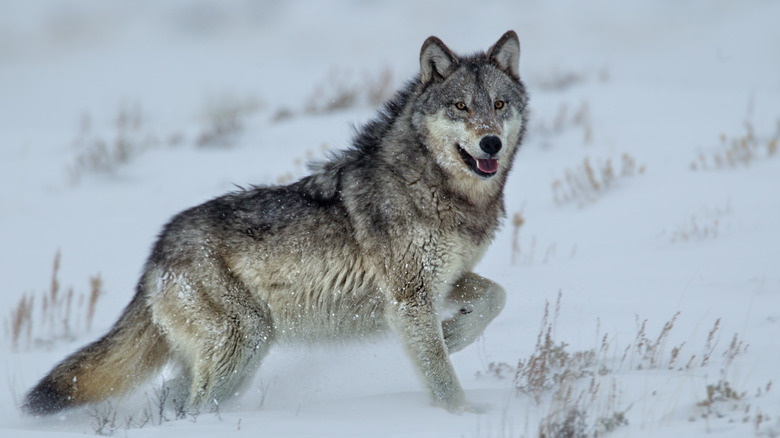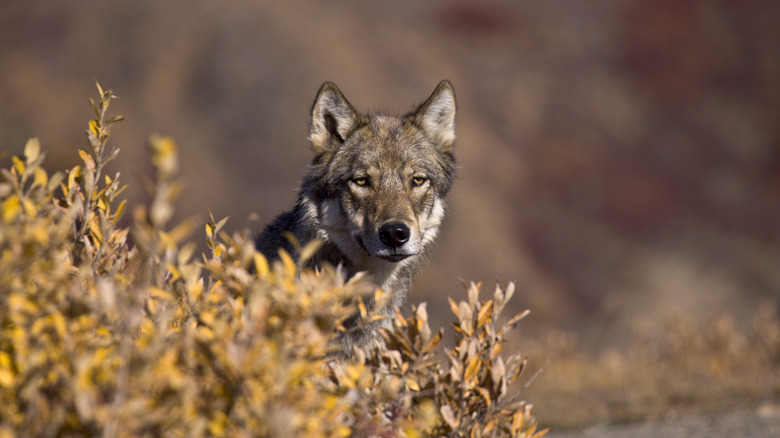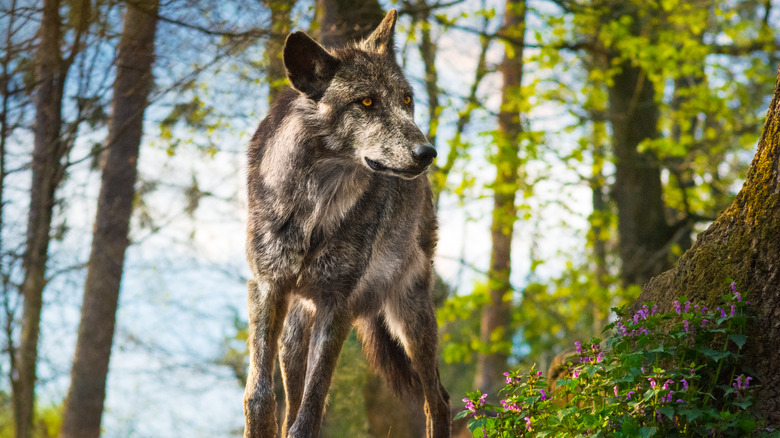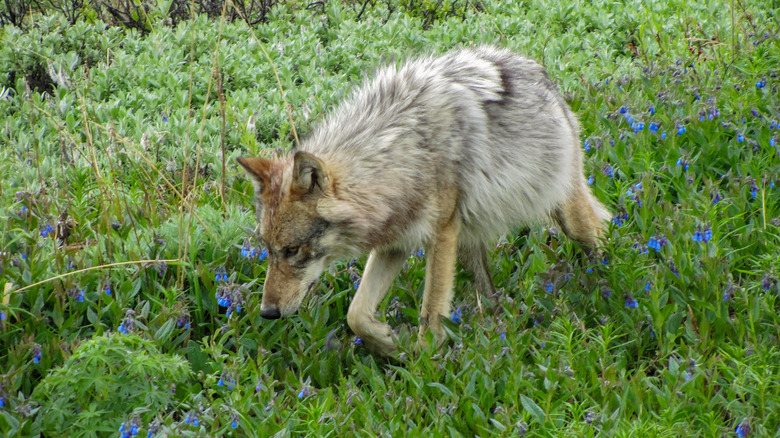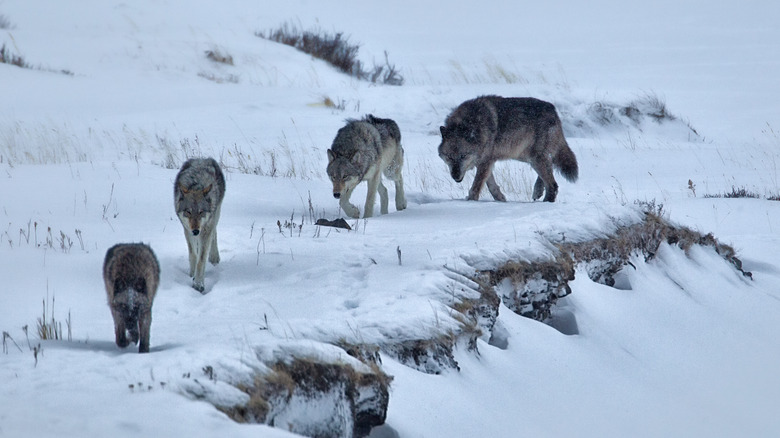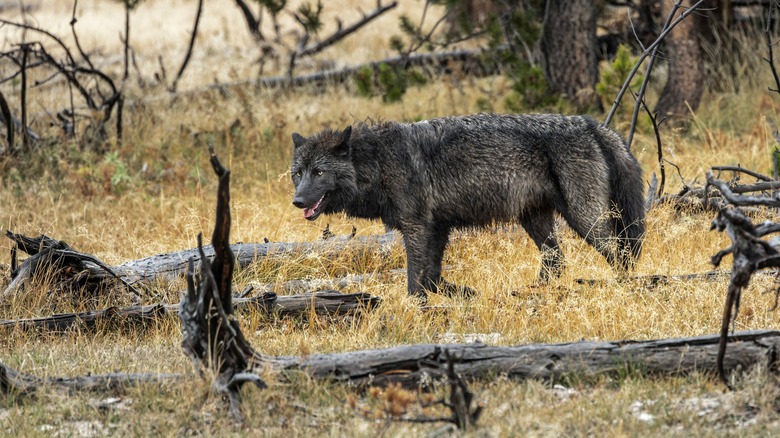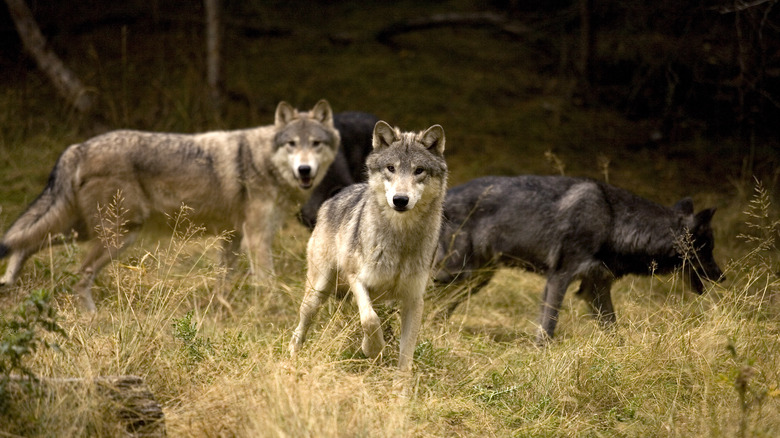What To Do If You Run Into A Wolf In The Wilderness
You might be hiking along Yellowstone National Park's Mount Washburn Trail, standing by a snowy river bank in Alaska's Denali National Park & Preserve, or rowing your way around Boundary Waters Canoe Area Wilderness in Minnesota. The air fills with the sounds of barks, yips, and howls. Suddenly, you see a pair of intense yellow eyes staring back at you. You are alone in the wilderness with a wild wolf.
This situation might sound chilling, but most of the time wolves are no threat to humans. Every year more than 100,000 people see a wolf in Yellowstone National Park alone, but in all of Europe and North America only 14 people were attacked by wolves between 2002 and 2020. As described in John D. C. Linnell, Ekaterian Kovtun and Ive Rouart of the Norwegian Institute for Nature Research's report, it's believed that the vast majority of attacks were caused by rabies.
In general, when wolves spot you, they will run away. As described by wolf recovery coordinator with the U.S. Fish and Wildlife Service Ed Bangs in an interview with The Denver Post, "If you're walking on a dark trail at midnight and you turn a corner and come across a pack of 20 wolves, enjoy them ... they'll be gone in a few seconds."
Alert the wolf
If you see a wolf or a wolf pack at a distance, feel free to stay where you are and quietly watch them. This is a rare opportunity to see these incredible animals in their natural environment. If the wolf is close to you, you should make some noise. As unbelievable as it might seem considering the incredible sense of smell wolves have, sometimes you will notice them before they notice you. If the wolf is close to you, it's a good idea to alert it to your presence so that you don't surprise it. Say something, shout, wave your arms, or clap your hands so that it realizes it is not alone. It's likely that the wolf will stop, look for the source of the noise, and then bolt when it spots you.
On some occasions, when a wolf notices you it may begin barking and howling. This isn't a sign of aggression, just that the wolf is as nervous about the interaction as you are.
If the wolf follows you
Sometimes, when you start to move away from a wolf, it may follow you at a distance. This can be terrifying, since it could seem like the wolf is intending to attack you, but usually, that's not the case. Usually, it means the wolf wants you to leave.
Wolves can be protective of certain areas. If they have a large kill nearby that they are hoping to eat, they may worry that you will try to take it from them. If you see them eating a carcass, you should leave the area quickly and let them eat. They are even more likely to be protective of their dens if they have cubs. If you've accidentally gotten too close, they will try to get you to leave.
As described by biologist Dr. Jay Shepherd, Wolf Program Lead for Conservation Northwest, wolves protecting their food or cubs may bark, snort, and circle you. They may even charge at you, veering off at the last second, in a threatening move called a bluff charge. The wolves are telling you to leave. Remain calm and leave the area they are protecting.
Don't run
Locking eyes with a wolf or suddenly coming upon a pack while in the wilderness could certainly be a frightening experience, but you should resist the impulse to run away. Generally, wolves are afraid of people, and after staring at you for a while they will run off in the opposite direction. You should not. As stated by wolf expert Oliver Starr (via Business Insider) wolves are what is known as coursing predators, which means that they hunt by chasing after and taking down prey that is running – typically creatures like deer, moose, elk, caribou and musk oxen. Not only are they able to take down running prey, that's the way they know how to hunt. Before attacking a wild animal, a wolf will try to spook it so that it runs away. Even though wolves do not usually view humans as food, you should not behave like their prey.
Even in a highly unlikely hypothetical situation in which a wolf is determined to attack you no matter what you do, running is a bad idea. Wolves are able to sprint at speeds of more than 36 mph, while Usain Bolt, the fastest human in the world, can only hit 27.5 mph.
Get loud
If you and a wolf are too close together, you should let it know that you are big, you are threatening, and you are not prey. Start by getting as large as you physically can. Stand up straight and wave your arms. Maybe even hold your jacket up over your head. Next, you should be as loud as possible. Shout angrily at the wolves. If you have a device you can use to get even louder, like an airhorn, use it. As stated by wolf expert Oliver Starr, "If you are noisy, don't exhibit excessive fear and maintain control of yourself, this should be enough to get you out of trouble."
Usually, wild wolves will run away when you display aggressive behavior like this. If the wolves are captive or particularly habituated to people, however, they may be bolder. While you never want to run or turn your back on a wolf or wolf pack, you still want to get out of there. While maintaining your loud, threatening behavior, you should back away. Be careful as you walk backwards, as tripping and falling would be extremely dangerous in this situation.
Fight back
Wolves that are extremely used to humans, in particular captive wolves, are much more likely to get into conflicts with people. Rabid wolves may also attack humans. Rabid wolves may display no fear of humans, approaching them, and trying to bite. You may be able to identify a wolf with rabies by its glazed expression, staggering walk, biting at nothing, heavy salivating, and lack of reaction when struck. Healthy wild wolves almost never attack humans, but in the extremely unlikely event that they do, you should fight back.
If a healthy wolf is behaving threateningly towards you and refuses to back down even when you make yourself large and loud, you should use bear spray. This is the safest option for both you and the wolves. If you don't have bear spray, start by throwing something at them while backing away. If it continues to come at you, attack it back, swinging anything you are holding as aggressively as possible, in order to show it that you are too dangerous to fight.
If the wolves overwhelm you and knock you to the ground, you might want to try curling up into a tight ball on the ground, covering your neck and face, but as stated by wolf expert Oliver Starr, it's unlikely that a single person could survive an attack like this from multiple wolves.
Reconsider bringing your dog into wolf territory
Wild healthy wolves have no interest in hunting humans and will only attack under very specific and rare circumstances. Having a dog with you can make the situation more risky. A wolf is far more likely to attack other wolves than people because wolf packs are territorial. As stated by Ed Bangs: "Wolves consider dogs as strange wolves. A dog may think that a wolf barking or howling is a dog that wants to play. Trust me, that is not the case."
While wolf attacks on dogs are still rare, they are much more common than wolf attacks on humans. If you have a dog with you, your presence may not be enough to stop your dog and a wolf from getting into a physical fight. If you try to break up a fight between your dog and wolves, the wolves may also attack you. Humans have been injured in the past protecting their dogs from wolves.
If you are going for a trip into the wilderness where wolves live, you should consider leaving your dog at home. If you can't, always alert wolves to your presence by traveling noisily and talking loudly as you go, and keep your dog leashed and close to you at all times.
